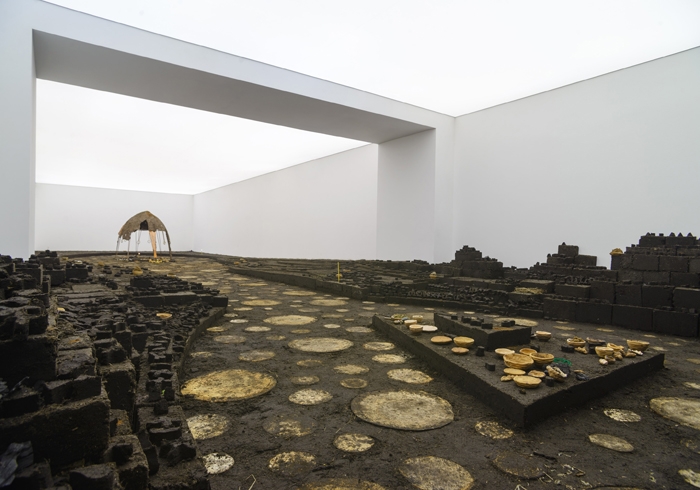Soil is an emotive material, packed with symbolism: that much is obvious. And in Dineo Seshee Bopape’s single-installation exhibition, there is a lot of it. Two interconnecting galleries filled with the stuff, a central gully of compacted soil running the length with small earth-cut steps flanking either side. On these rest more soil, moulded into small sculptural forms (mostly cubes and crosses). Along the path, one must navigate several geometric raised islands, all with further cookie-cutter mud shapes, together with a few candles and a dozen or more wooden bowls. A domed mud-roofed wooden structure stands at the furthest end of the space.
The South African artist first introduced this now-signature material to her work at the Marrakech Biennale in 2015. There she paid homage to Azania, an apartheid-era liberation song that includes the lyrics “From Cape Town to Cairo, Morocco to Madagascar… Azania, our land, we will get it via bazookas”. For that work the artist included soil samples from the quartet of places named in the song, the four peripheries of Africa. The dirt in Kiev is Ukrainian. It might be easy therefore to think of the current land conflict in the east of the country, of questions of ownership and identity (in Donbass and Crimea, where Russian is the most common first language, a bloody covert war is being fought between Ukraine and its aggressive neighbour). I’ve seen a similar work by Seshee Bopape before, at another biennial, this time in 2016, in São Paulo: there my mind turned to questions of colonialism, and the land rights of the Amerindian people. Seeing her sculptures in these different geographical contexts – and seeing how they easily slide into speaking of different political conflicts – could lessen their impact. This commission by the Pinchuk Art Centre is a result of the artist winning the 2017 edition of the Future Generation Art Prize, juried by a retinue of air miles-collecting super-curators. Could Seshee Bopape just be the perfect artist to provide requisite ‘glocal’ signifiers, her sculpture able to adapt chameleonically to whatever domestic issue is most pressing?
Yet the overall effect of walking through this work – and very seductive it is too – is that of interrupting a ceremony or ritual to a god or gods unknown. From the earth, shoots sprout. There is something deeper, perhaps more mystical about this setup; less earthbound, ironically, than the geopolitical reading (spurred on by those song lyrics) that I’ve taken from the artist’s previous work. Instead, this untitled installation leads one beyond political squabbles to notions of Mother Earth, of birth and death, and of our eventual return to the ground. If this makes the work seem unappealingly hippyish, it should not. As the environmentalist George Monbiot points out, ‘Soil is an almost magical substance, a living system that transforms the materials it encounters, making them available to plants’. A teaspoon of earth apparently contains more microorganisms than there are human beings, and all of them essential to our continued existence: the artist is using a material that is at the forefront of green struggle. This then is still a deeply political work: just one in which the politics goes beyond the human.
Dineo Seshee Bopape at Pinchuk Art Centre, Kiev, 24 February – 13 May 2018
From the Summer 2018 issue of ArtReview
